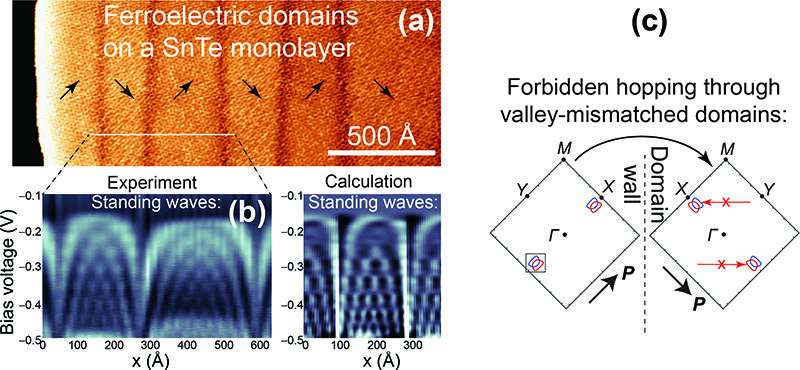Demonstration of standing waves on a ferroelectric SnTe monolayer: (a) Experimental image of the monolayer. Arrows show the direction of the intrinsic dipole moment. Vertical dark features are domain walls. (b) Experimental and theory verification of standing waves. (c) Diagram indicating a momentum mismatch across domains responsible for the observed standing waves. Credit: University of Arkansas
According to the rules of quantum mechanics, electrons behave as particles or waves. Similar to the walls of a water reservoir, "electrostatic potential walls" can be created to confine electrons to desired spatial regions, known to physicists as "quantum corrals." Confining electrons allows physicists to work with them, the experimental counterpart to "particle in a box" exercises in undergraduate-level quantum mechanics.
But the symmetry created by a material that contains electrons can also be used to confine them without using large potential walls. Indeed, in so-called "quantum materials" that are atomically thin, the electron momentum can become extremely specific such that if small currents are created, electrons possess a very precise momentum. The electron's few options for momenta are so specific that they are even given a name: "valleys."
Ferroelectricity is the creation of an intrinsic electric dipole moment. Add ferroelectricity to an atomically thin material and the number of valleys becomes reduced due to a lowered symmetry of the atoms forming the material: in the material studied here—a SnTe ("tin telluride") monolayer—such ferroelectricity creates a horizontal displacement of nearest atoms that in turn reduces the number of available valleys to only two. In work recently published in Physical Review Letters, the mismatch of electronic momentum across domain walls (i.e., regions with a different orientation of the intrinsic electric dipole) is shown to create standing waves, even though there is no potential buildup across the domain wall.
In theoretical work performed in collaboration with experimental groups at China and Germany, doctoral fellow Brandon J. Miller and Salvador Barraza-Lopez, an associate professor of physics, recreated the SnTe monolayer experimentally observed in the figure (a) to verify the creation of standing waves (b). The phenomena was shown to arise from the valley mismatch across domain walls (c).
These results are important in a number of ways. First, they demonstrate a new coupling between ferroelectricity and the valley degree of freedom in two-dimensional materials, such that ferroelectricity can be used to control the number of available valleys. (Electronic devices based on the valley degree of freedom, such as memory devices based on these ferroelectric domains, have been proposed by other scientists, but the coupling of valley to ferroelectric behavior here observed is brand new). In addition, knowledge of the spacing among domain walls, and of the number of bright spots at a given bias showing constructive interference, makes it possible to infer the electronic structure of these ferroelectrics, making the experimental techniques employed the first known confirmation of their predicted electronic structure.
More information: Kai Chang et al. Standing Waves Induced by Valley-Mismatched Domains in Ferroelectric SnTe Monolayers, Physical Review Letters (2019). DOI: 10.1103/PhysRevLett.122.206402
Journal information: Physical Review Letters
Provided by University of Arkansas
























